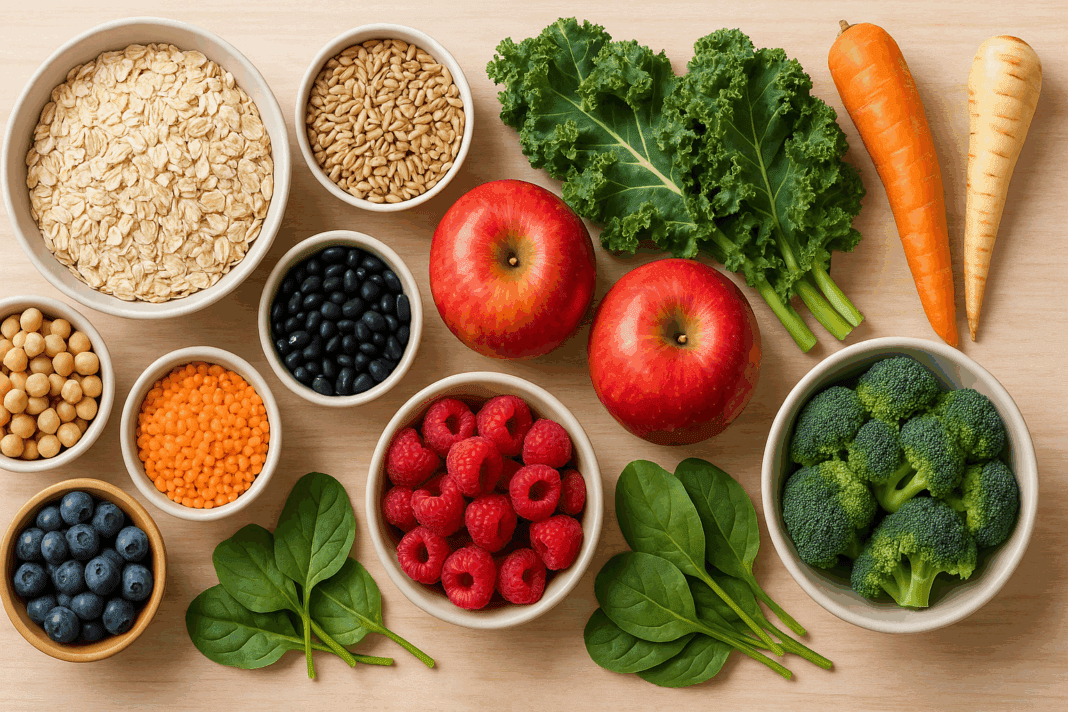Introduction: Why Fiber Matters for Gut Health
In the quest for optimal digestive wellness, understanding the types and sources of fiber becomes essential. A balanced diet rich in fiber is one of the most effective ways to support gut function, prevent constipation, and cultivate a diverse microbiome. Central to this approach is knowing how to incorporate a complete list of soluble and insoluble fiber foods into everyday meals. These two forms of fiber perform distinct yet complementary roles within the gastrointestinal tract. Soluble fiber dissolves in water, often forming a gel-like substance that helps slow digestion and modulate blood sugar levels, while insoluble fiber adds bulk to stool and facilitates efficient bowel movements. For anyone seeking to naturally support gut health, the knowledge of which foods offer these fibers—and how they work together—is invaluable.
You may also like: The Ultimate Guide to Gut Healthy Meals: Best Meals for Gut Health and Nourishing Recipes You’ll Love

Understanding Soluble and Insoluble Fiber: The Science Behind Digestive Balance
To fully appreciate the benefits of fiber for gut health, it is important to explore the distinct functions of soluble and insoluble fiber. Soluble fiber is known for its ability to dissolve in water and form a viscous gel during digestion. This characteristic slows the movement of food through the digestive system, which helps regulate glucose absorption and promotes satiety. It is especially useful for individuals managing diabetes or looking to lower cholesterol. On the other hand, insoluble fiber does not dissolve in water. Instead, it retains its structure as it moves through the digestive tract, helping to add bulk and speed up intestinal transit. This function is crucial in preventing constipation and maintaining regularity. A diet that lacks either form can disrupt the delicate equilibrium of the gut, leading to symptoms such as bloating, irregularity, and poor microbial diversity. Integrating both forms is the foundation of a fiber-rich, gut-supportive nutritional approach.
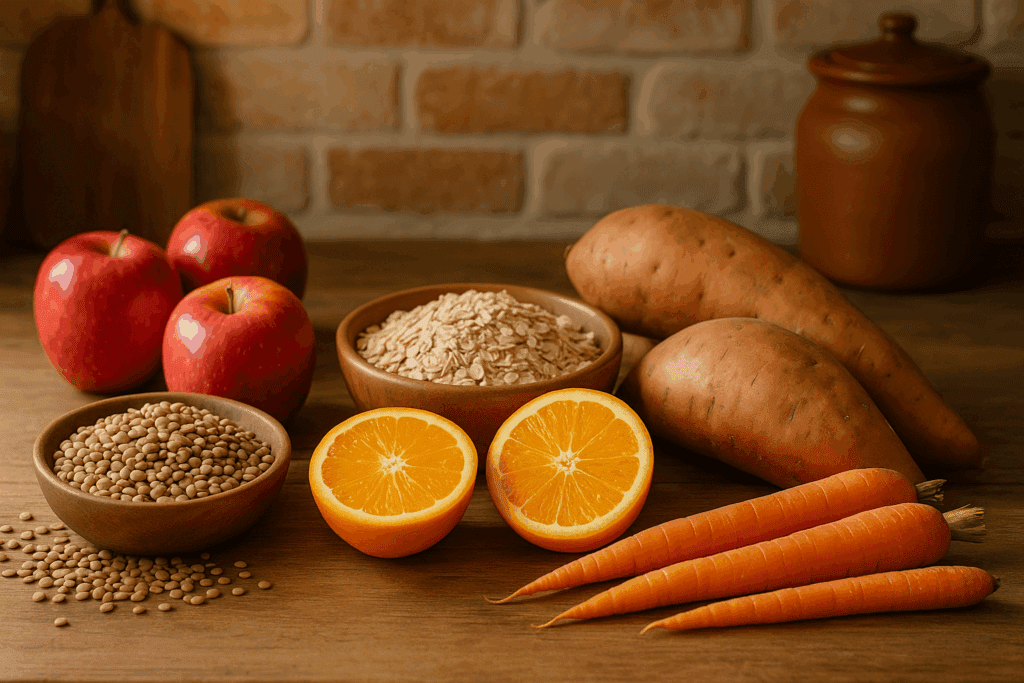
Foods Containing Soluble Fiber: The Natural Gel Builders
Among the most frequently asked questions in gut health nutrition is: does soluble fiber form gel in water? The answer is yes, and it is this unique property that makes soluble fiber such an important dietary component. Soluble fibers, such as pectin, beta-glucan, and gums, are found in a range of plant-based foods. They are particularly abundant in oats, legumes like lentils and chickpeas, as well as fruits such as apples, oranges, and pears. Vegetables like Brussels sprouts, sweet potatoes, and carrots also contain significant amounts. When consumed, these fibers help create a gel-like consistency in the intestines, slowing digestion and encouraging beneficial bacteria to thrive. For individuals exploring gut health supplements, food sources of soluble fiber offer a more holistic and effective alternative. When integrated into a meal plan thoughtfully, these foods not only support digestion but also enhance overall metabolic health.
The Soluble Fiber Foods List: Building a Gut-Healthy Diet
Creating a diverse and nutrient-rich soluble fiber foods list can empower individuals to build meals that enhance gut function. Oatmeal, for example, is a staple in many high-fiber diets due to its content of beta-glucan, a form of soluble fiber with proven cholesterol-lowering effects. Legumes, including kidney beans, black beans, and navy beans, offer substantial amounts of both fiber types, but particularly excel in soluble fiber content. Fruits such as bananas, berries, and plums are not only rich in vitamins and antioxidants but also contribute significantly to daily soluble fiber intake. Even certain nuts and seeds, such as flaxseeds and chia seeds, provide a healthy dose. Including a variety of these foods ensures an optimal intake and supports smoother digestion, steadier blood sugar, and a more robust microbial community within the gut.

Soluble Fiber Fruits: Natural Digestive Allies
Among the top contributors to dietary soluble fiber, fruits hold a special place. Soluble fiber fruits such as apples, citrus fruits, and strawberries are rich in pectin—a type of fiber that becomes viscous in the gut and helps reduce spikes in blood sugar. Apple soluble fiber, in particular, is highly regarded for its ability to support a healthy digestive tract while offering anti-inflammatory benefits. Oranges and other citrus fruits contain soluble fibers like pectin and mucilage, which play key roles in cholesterol metabolism and gut barrier function. Berries, with their skin-on composition, provide both soluble and insoluble fibers in balanced quantities. Including fruits as part of a fiber-rich breakfast or snack offers a refreshing, nutrient-dense way to nourish gut health. Moreover, the natural sugars in fruit are moderated by their fiber content, reducing the likelihood of rapid glucose spikes.
Foods High in Soluble Fiber Chart: A Reference for Optimal Gut Function
While it is valuable to discuss foods anecdotally, a foods high in soluble fiber chart can serve as a useful reference for those building a gut-friendly meal plan. At the top of this chart, oats, barley, and beans consistently rank high. Fruits such as apples, oranges, and avocados also make the list, along with root vegetables like carrots and turnips. This resource is not only helpful for individuals trying to improve digestion, but also for dietitians and health practitioners developing client-focused nutrition strategies. The chart typically categorizes foods by portion size and estimated grams of soluble fiber, offering practical guidance for meal preparation. By regularly consulting such a chart, one can ensure they are consuming a balanced amount of soluble fiber daily, contributing to smoother digestion and better nutrient absorption.
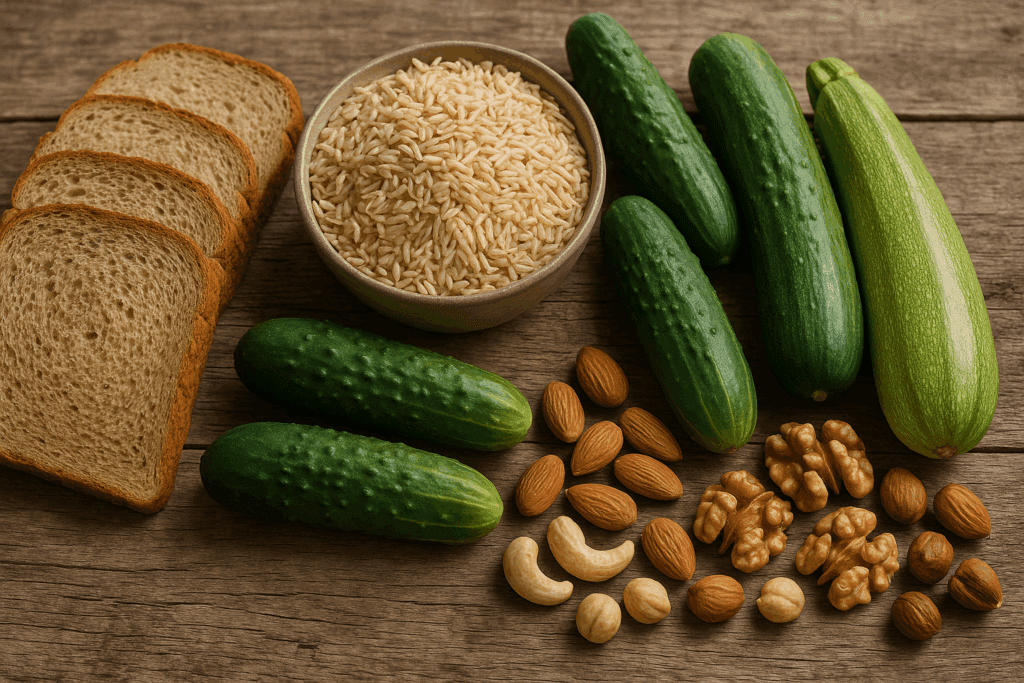
List of Soluble and Insoluble Fiber Foods: A Comprehensive Digestive Blueprint
To maximize digestive health, one must look beyond isolated food items and consider a full-spectrum list of soluble and insoluble fiber foods. This inclusive dietary blueprint encourages the integration of both types of fiber through whole, plant-based nutrition. Soluble fiber foods like oats, apples, and lentils work synergistically with insoluble counterparts such as whole wheat, cauliflower, and green beans. The goal is not to prioritize one type over the other, but rather to curate meals that contain both. Such an approach supports digestive motility, microbial diversity, and reduced risk of inflammatory conditions. This balance becomes especially important for those with gastrointestinal disorders, who may need to fine-tune their fiber intake depending on symptom severity. Understanding and utilizing this list in a personalized and informed way transforms it into more than a nutritional guide—it becomes a roadmap to long-term gut wellness.
Insoluble Fiber Foods List for Constipation: Promoting Regular Bowel Movements
Constipation is one of the most common digestive complaints, often resulting from insufficient intake of insoluble fiber. The insoluble fiber foods list for constipation includes wheat bran, whole wheat bread, brown rice, cucumbers, zucchini, and nuts. These foods retain their structure as they pass through the digestive system, adding necessary bulk to stool and helping waste move efficiently. This mechanical action stimulates the gut lining and promotes peristalsis, or the rhythmic contractions that move food through the colon. For those struggling with sluggish digestion, increasing the intake of insoluble fiber through these whole foods can result in significant relief. Additionally, insoluble fiber complements the softening effect of soluble fiber, ensuring that stools are both hydrated and formed, reducing discomfort during elimination. Over time, a consistent intake of these foods contributes to normalized bowel habits and a more predictable digestive rhythm.
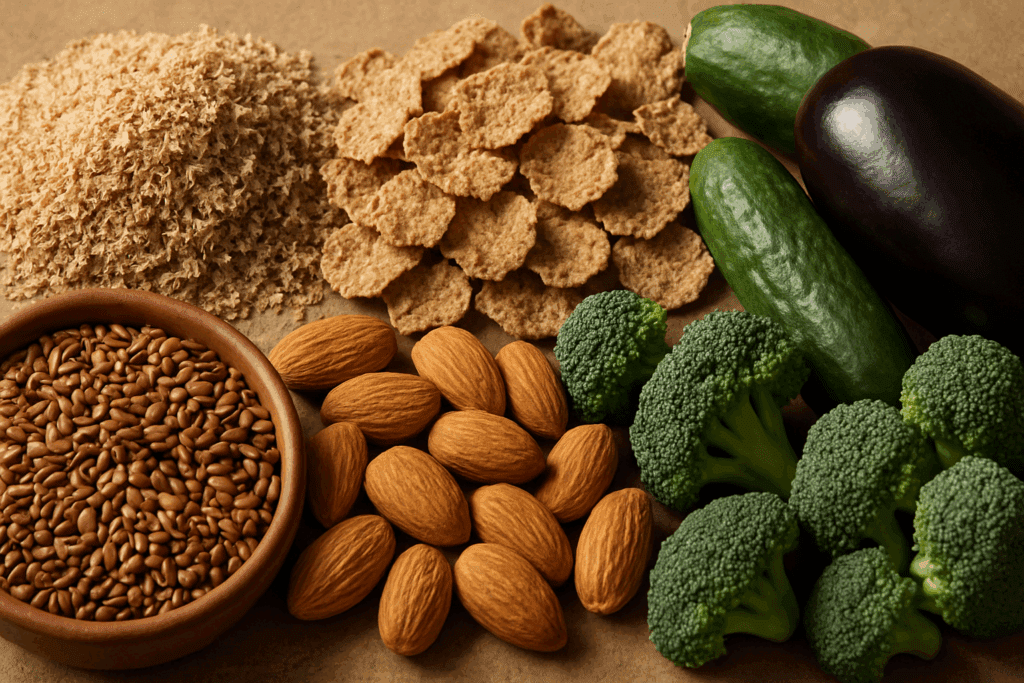
Best Sources of Insoluble Fiber: Reinforcing the Structural Backbone of Digestion
Identifying the best sources of insoluble fiber can help individuals target their dietary changes with precision. Whole grains are among the most potent sources, with brown rice, bulgur, and whole wheat products providing substantial benefits. Vegetables such as green peas, celery, and bell peppers also contain significant amounts. The structural integrity of insoluble fiber provides resistance to fermentation in the colon, meaning it moves through largely unchanged. This unique property aids in forming bulk and expelling waste efficiently. Moreover, the consumption of these foods supports colon health by minimizing the time potentially harmful substances remain in contact with the gut lining. For individuals with high-fiber needs—such as those recovering from antibiotic use or aiming to rebalance their microbiota—these insoluble-rich foods are foundational. Integrating them into lunches, dinners, and snacks can ensure ongoing digestive resilience.
Highest Insoluble Fiber Foods: Building a Robust Digestive Foundation
When aiming to increase the structural component of dietary fiber, it is helpful to identify the highest insoluble fiber foods. These include wheat bran, whole grain cereals, flaxseeds, almonds, and vegetables with skins, such as cucumbers and eggplants. These foods are not only fiber-dense but also rich in nutrients that support general wellness, such as magnesium, zinc, and polyphenols. Their fibrous matrix resists breakdown, aiding in bowel regularity and providing a mechanical scrub to the intestinal walls. This helps prevent buildup and fosters a cleaner, more efficient digestive environment. Consistently incorporating these foods into meals fortifies the gut against stagnation, inflammation, and microbial imbalance. They can be particularly helpful for individuals transitioning from a low-fiber diet, offering a tangible way to restore gut integrity and reduce the likelihood of gastrointestinal disturbances.
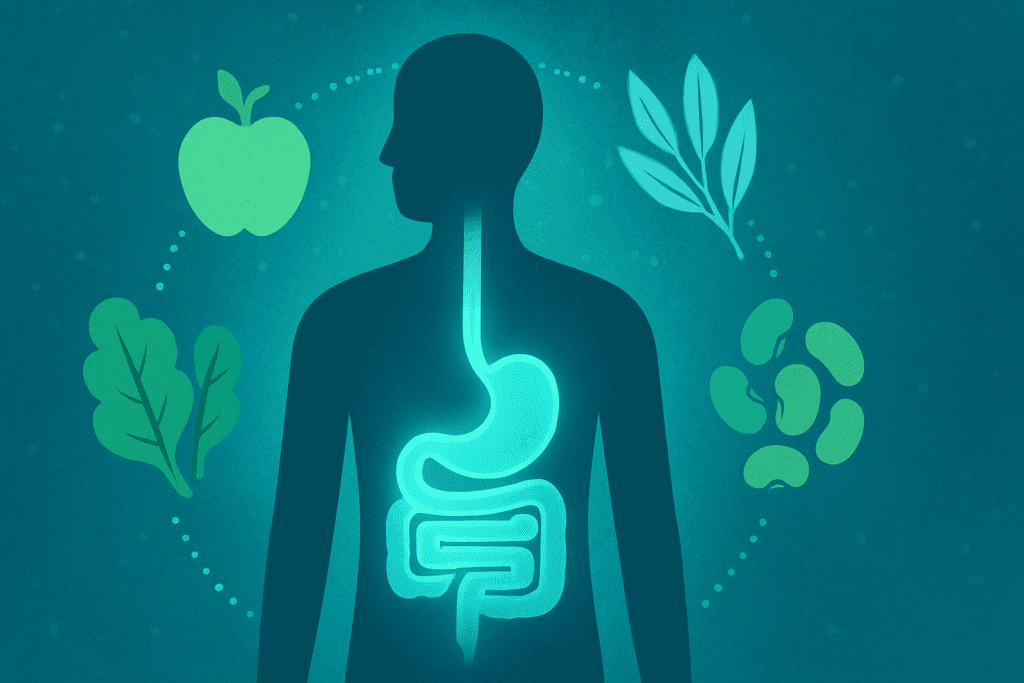
Fibre Soluble and Insoluble Food List: A Functional Approach to Everyday Meals
For practical application, a fibre soluble and insoluble food list can guide everyday food choices in a functional, goal-oriented way. Breakfast might include oatmeal with berries and a sprinkle of flaxseeds, delivering both soluble and insoluble fibers. Lunch could feature a lentil salad with chopped bell peppers and a slice of whole grain bread. Dinner might include roasted root vegetables with a side of brown rice. The goal is to approach fiber intake not as a supplement or add-on, but as a foundational element of each meal. This integrative mindset reduces reliance on artificial digestive aids and promotes a more intuitive relationship with food. Moreover, it encourages culinary creativity—exploring fiber-rich recipes that are both nourishing and satisfying. Over time, this approach cultivates a lifestyle rooted in digestive vitality.
Frequently Asked Questions: The Essential Guide to Fiber and Gut Health
How can I use a list of soluble and insoluble fiber foods to meal prep for digestive health?
A strategic approach to meal prep using a list of soluble and insoluble fiber foods involves more than just variety—it’s about balance and timing. For example, soluble fiber foods like oats and lentils can form the foundation of your morning and midday meals, helping regulate digestion and blood sugar. Evening meals can incorporate foods high in insoluble fiber, such as roasted vegetables with skins and whole grains, to stimulate healthy bowel movements. Prepping meals in advance ensures you consistently meet your fiber goals without relying on processed options. The key is to create diversity across meals while keeping portions realistic for your digestive tolerance.
Why does soluble fiber form gel in water, and what does that mean for my gut?
The unique ability of soluble fiber to form gel in water has significant implications for gut function. This gel slows the movement of food through the intestines, which can promote fullness and improve blood sugar regulation. From a microbiome perspective, it also provides fermentable substrate for beneficial gut bacteria. In practical terms, this means that including foods containing soluble fiber—such as barley or psyllium—can support not just digestion but also immune response and even mood. The gel-forming property is what allows soluble fiber to act as both a metabolic moderator and microbial ally.
Are there any overlooked foods in the soluble fiber foods list that offer surprising health benefits?
Yes, many lesser-known items in the soluble fiber foods list can be nutrient powerhouses. For instance, Jerusalem artichokes are high in inulin, a soluble prebiotic fiber that fosters beneficial bacteria growth. Seaweed, particularly wakame and kelp, contains alginate—a soluble fiber with promising effects on fat absorption and gut motility. Even okra, often overlooked, is rich in mucilaginous soluble fiber that soothes the digestive lining. Including these underrated foods adds diversity and expands your microbiome’s adaptability. They also offer a broader range of phytonutrients not typically found in standard Western diets.
How do athletes benefit from a high intake of foods high in soluble fiber chart recommendations?
For athletes, the foods high in soluble fiber chart can serve as a guide to optimize energy levels and recovery. Soluble fiber helps regulate glucose absorption, minimizing energy crashes during workouts. It also supports stable gut motility, which is essential for athletes who experience GI distress from endurance activities. Furthermore, soluble fiber promotes the growth of bacteria that produce short-chain fatty acids, known to enhance nutrient absorption. Strategic consumption of foods like bananas, beans, and chia seeds can thus contribute to both performance and long-term gut resilience.
How can I personalize the fibre soluble and insoluble food list for sensitive digestion?
Personalizing a fibre soluble and insoluble food list begins with tracking how your gut responds to specific items over time. If you experience bloating or discomfort, it may be helpful to slightly reduce certain insoluble fibers while increasing gel-forming soluble fiber. Introducing cooked vegetables instead of raw ones can also ease digestion. You might also find relief by spreading fiber intake evenly throughout the day rather than consuming it all at once. Keep in mind that hydration is essential—without sufficient water, fiber can become constipating rather than relieving.
What are the social or cultural implications of the insoluble fiber foods list for constipation?
The insoluble fiber foods list for constipation often includes whole grains and vegetables with skins, which may not be prevalent in all cultural cuisines. For example, in rice-based cultures where white rice predominates, fiber intake can be lower unless vegetables, seeds, or beans are emphasized. In such cases, culturally appropriate alternatives like fermented vegetables or mixed grains can fill the gap. Additionally, social eating patterns—such as eating on the go—can reduce opportunities to consume whole, fiber-rich foods. Addressing these barriers through culturally sensitive dietary education can lead to better compliance and gut health outcomes.
What are the best sources of insoluble fiber for vegans with limited food access?
Vegans with limited access to diverse produce can still access the best sources of insoluble fiber by focusing on shelf-stable options. Whole wheat flour, brown rice, and dried beans provide reliable and affordable insoluble fiber. Even frozen vegetables like spinach and green beans retain their fiber integrity and offer year-round convenience. For those in food deserts, canned goods like chickpeas and lentils—when rinsed—can still serve as excellent fiber boosters. The goal is to build a fiber-focused pantry that aligns with budget and availability without compromising digestive health.
How does apple soluble fiber differ from fiber in other fruits?
Apple soluble fiber primarily consists of pectin, which is particularly effective at binding with water and toxins in the gut. This contrasts with citrus fruits that also contain mucilage or bananas that contain resistant starch. Pectin from apples can help regulate blood lipids and reduce gut inflammation more effectively than some other fruit fibers. Including apple soluble fiber regularly may also benefit those with irritable bowel conditions due to its mild nature. The peel contains insoluble fiber too, making apples a dual-function fruit in the fiber hierarchy.
Can a list of soluble and insoluble fiber foods help manage age-related digestive issues?
Yes, using a list of soluble and insoluble fiber foods can help address common age-related digestive changes such as reduced motility and microbiome diversity. As people age, natural peristalsis can slow down, and intestinal sensitivity may increase. Soluble fibers help by softening stools and nourishing gut flora, while insoluble fibers stimulate the colon to reduce transit time. Furthermore, fiber helps mitigate age-associated inflammation, which can impact not only digestion but also cognitive and metabolic health. A tailored fiber intake strategy can therefore play a vital role in aging gracefully with a healthy gut.
How do new technologies influence our understanding of the highest insoluble fiber foods?
Advancements in nutritional science and gut microbiome testing have reshaped how we assess the highest insoluble fiber foods. Molecular profiling now allows us to see how different fibers interact with specific bacterial strains. Some vegetables once thought to be moderate in insoluble fiber have shown higher-than-expected fermentability, broadening their recognized benefits. Additionally, precision agriculture and food labeling improvements make it easier to compare fiber content across food types. As databases expand and testing becomes more accessible, our understanding of fiber-rich foods continues to evolve, allowing for smarter dietary planning and intervention.
Conclusion: Empowering Gut Health with the Right Fiber Choices
In the journey toward better digestion, clarity around fiber’s role is a transformative first step. By embracing a complete list of soluble and insoluble fiber foods, individuals can take control of their gut health in a sustainable, natural way. Soluble fibers soothe and regulate, while insoluble fibers stimulate and cleanse—their combined action creating a harmonious environment within the gut. Recognizing which foods offer these fibers allows for strategic meal planning that supports not only digestion, but also broader health outcomes such as weight regulation, blood sugar control, and cardiovascular wellness. As dietary choices evolve, using resources like the soluble fiber foods chart or the fibre soluble and insoluble food list can empower individuals to stay informed and proactive. Ultimately, investing in the right fiber sources is more than a nutritional tactic—it is a foundational pillar of holistic, long-term wellness.
Further Reading:
Top 20 Foods High in Soluble Fiber
25 Insoluble Fiber Foods & Surprising Benefits Beyond Constipation Relief

